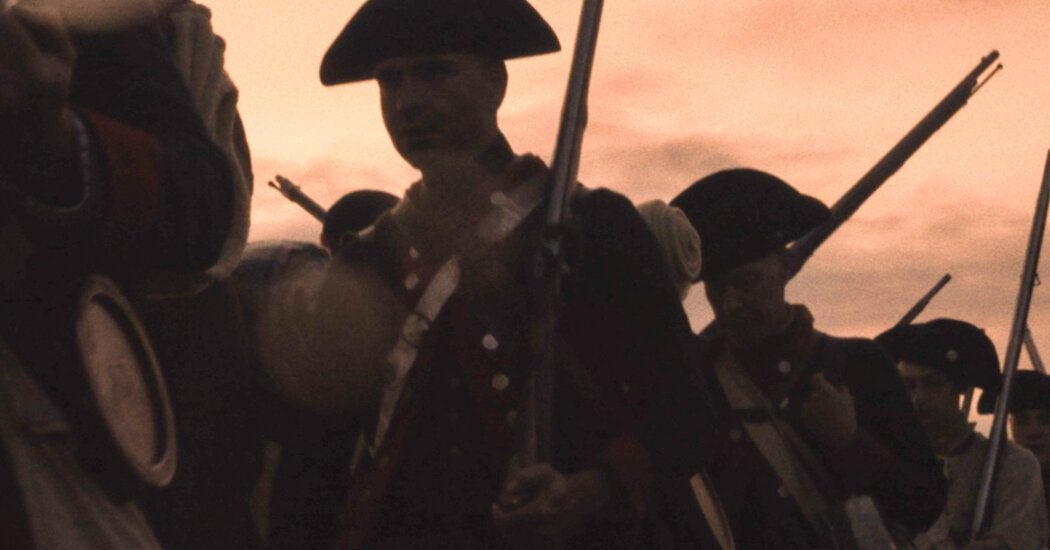
In 1990, Ken Burns established his reputation with an enormous PBS documentary about a civil war. Thirty-five years later, with “The American Revolution,” he’s made another one.
We may not be used to thinking of the fight for independence from Britain that way. But this sweeping and sneakily provocative six-part series, which begins on PBS on Nov. 16, says that we should.
“The greatest misconception about the American Revolution it that is was something that unified Americans,” the historian Alan Taylor says in the second episode. “It leaves out the reality that it was a civil war among Americans.”
Part of that division involved the bitter and often savage recriminations between pro-independence Americans and those loyal to Britain. But those were not the only Americans at battle. As “The American Revolution” emphasizes, the war was also often a struggle between American colonizers and Native Americans, between enslavers and the enslaved. Some Americans won their sovereignty and freedom. Others — particularly non-European Americans — lost it.
“The American Revolution” is not Burns’s most innovative film; its techniques and rhythms are familiar from “The Civil War” and its successors. It is not his most moving; that title likely goes to his 18-hour heartbreaker, “The Vietnam War.” But it is perhaps his best-timed, and not only because the country’s 250th anniversary is coming next year but also because Americans are again passionately and even violently divided, over matters including history itself.
It arrives as public broadcasting, along with its mission to speak to every part of America, has been perhaps mortally wounded. It comes in an era of political violence and cultural war over American history, with deeply divided camps claiming the mantle of 1776.
And it is dedicated to a belief that seems increasingly old-fashioned: that we share a common story and that people are willing to hear it, both the good and the bad. There was a time when Burns’s expansive tales of the past could draw a broad audience of Americans, whatever their differences in the present. Perhaps that too is now history.
ON THE SURFACE, “The American Revolution” — directed by Burns with Sarah Botstein and David Schmidt and written by his longtime collaborator Geoffrey C. Ward — is exactly what Burns’s past documentaries and your memories of grade-school history class would lead you to expect.
Peter Coyote’s familiar, soothing narration tells of a rebellion that was not guaranteed to succeed. It lays out the Enlightenment ideals that inspired America’s fledgling democracy. It builds tension through the patriots’ early military disasters, illustrating battles with red and blue arrows snaking across parchment-hued maps, from land to sea, city to frontier, Lexington to Yorktown.
As in “The Civil War,” Burns and company create the kinetic illusion of war footage, cutting between artworks and re-enactment images to the sound effects of cannon. There are long, ugly descriptions of bayonet warfare. The war it depicts is not the jolly enterprise of fifes and drums and men in powdered wigs but savage, sweaty butchery, often among neighbors.
Also as in “The Civil War,” Burns enlists a troupe of celebrities to voice historical figures and common people. George Washington (Josh Brolin) emerges as a complicated hero, a field general who made numerous tactical mistakes but who also had the singular personal magnetism and character to hold together exhausted troops and squabbling politicians.
So far, so History 101. But the film also makes clear quickly that there is more to this story. The introduction shifts from Thomas Paine (Matthew Rhys) urging resistance against tyranny to a description of the Haudenosaunee Confederacy, a Native American democracy that long preceded the United States. It weaves in the voices of enslaved Black Americans, who fought on both sides of the war. (Washington, the historian Christopher Leslie Brown says, worried that having them fight alongside white soldiers would undermine the institution of slavery.)
Over its 12 hours, “The American Revolution” takes two parallel tracks: the stories of white leaders who would eventually appear on dollar bills and in portrait galleries, and those of Americans of color, who were often used as pawns or had to choose which side of the war offered them the best chance at autonomy.
These multiple tracks, in the film’s telling, are part of the same larger story. The revolution was part of a worldwide war involving British colonies stretching to the Caribbean and Asia. And a big motive of the colonists, the film argues, was westward expansion into Native American lands beyond the Appalachians, which the British had forbidden (and in which Washington, among others, had financial interests).
The result is neither a glorification of the revolution nor a condemnation of the founding fathers. It’s just an attempt to bring in as many affected voices as possible, to situate “the most consequential revolution in history” in a global context, to make America’s founding story even bigger than you were originally taught.
THIS SHOULDN’T BE CONTROVERSIAL. It is simply history for grown-ups, which assumes that people can accept both that the revolution was a triumph for the idea of liberty and that the revolutionaries who fought it didn’t live up entirely to their beautiful words.
It is also the kind of story Burns has been telling for decades. “The Civil War” established an aesthetic style — the pans across old photos, the plangent fiddle music — as well as a people’s history approach that put the stories of foot soldiers and civilians on the same level as those of presidents and generals. The series drew some criticism, including that it was too sympathetic to Southern rationalizations for the war, but around 40 million Americans tuned in for a long-form history lesson whose most whiz-bang special effects were tintype photographs.
Burns’s approach hasn’t really changed much. There are some new tools, like 3D graphics, and some nods to the times. (“The Civil War” referred to “slaves”; “The American Revolution” talks about “enslaved people,” the preferred term among those who argue that it is dehumanizing to define people by their status as property.) You could imagine a timeline when “The American Revolution” would seem nothing more than an earnest, slightly dull prequel to “The Civil War.” But in our actual timeline, America, with a landmark birthday approaching, is in the midst of a pitched war over its own past. In this timeline, “The American Revolution” feels urgent, necessary and maybe even risky.
The second Trump administration has been purging cultural institutions of the barest whispers suggesting that the country’s history was anything but glorious triumph. The president has criticized the Smithsonian Institution for focusing on “how horrible our Country is, how bad Slavery was” and had its museums scrutinized for their “alignment with American ideals.”
His administration has ordered the renaming or review of military ships named for civil rights leaders and the restoration of military base names that honored Confederate generals. It has thrown out symbols of diversity and social progress in favor of celebrations of tradition and dominance. And the military parade that President Trump threw on his birthday, under the banner of the America250 semiquincentennial celebration, suggests he may cast next year’s anniversary in his own aggressive image.
When you control how people discuss the past, you control how they see the present and imagine the future. No wonder the country’s political movements have also fought to claim the legacy of ’76, from the Obama-era Tea Party to the current “No Kings” protests, whose anti-royalist branding is straight out of “Schoolhouse Rock.” The president has joined the war of symbolism too. On the day of massive demonstrations in October, the president shared a fake video of himself flying a military jet, wearing a golden crown and dumping excrement on the marchers.
“THE AMERICAN REVOLUTION” COULD be a teaching moment right now, a chance to find common ground, a reminder and warning about a volatile time when neighbors sought retribution against neighbors.
Though the film was in production for over eight years (around as long as the war for independence took to fight), it feels pointedly current. Sometimes the parallels are subtle. The film notes that Washington mandated smallpox inoculations for soldiers, and it’s hard to imagine that anyone in the editing room was unaware of the Covid vaccine battles. The resentments of frontier settlers over limits on expansion recall the grievances of modern rural politics.
Other similarities hit, as history often does, square on the nose. As the current administration sends the National Guard into cities over the objections of local officials, the film describes the British alienating Bostonians by sending an army — citing security concerns — to occupy the city. “Good God,” says the Rev. Andrew Eliot (voiced by Tom Hanks), “what can be worse to a people who have tasted the sweets of liberty?”
And as the film describes the draft constitution’s balance of powers, the choice of emphasis is hard to ignore. “They feared that a demagogue might incite citizens into betraying the American experiment,” Coyote says. “Alexander Hamilton was concerned that an ‘unprincipled’ man would ‘mount the hobby horse of popularity’ and ‘throw things into confusion.’” The script names no current names, but critics of President Trump have cited this quote for years.
Meanwhile, the return of Burns, one of PBS’s biggest non-Muppet stars, is a meta-testament to another current story — the war on public broadcasting. The funding credits of “The American Revolution” note that it was “made possible, in part, with support from the Corporation for Public Broadcasting.” That organization announced plans to shut down next year, after Congress clawed back $1.1 billion in funding.
Burns has called the cuts “short sighted” but said he will personally be able to continue his work. He’s in the position to do that because of the support public TV provided him from early on. But Burns is 72. Who will support his successors? In a media environment that rewards flash, conflict and catering to ideological bubbles, what other network will tell Americans, all Americans, that they share a common set of facts, a common history and common challenges?
Of course “The American Revolution” does not address the public-broadcasting controversy or the continuing fights over public history in museums and universities, but it is an implicit part of those arguments. The series makes its case the way Burns’s whole body of work has: by trying to tell a full story and trusting, maybe with quaint optimism, that all kinds of Americans will want to hear it.
The series might well draw controversy pointing out the founders’ contradictions. But “The American Revolution” is also deeply patriotic. It gushes with love for America’s natural beauty, for its democracy and for its professed, if not always realized, ideals.
In its telling, the American story is one of always striving to get closer to those ideals — not of being perfect but of becoming more perfect. Its closing words are “The revolution is not over.” You can take that as a tribute to how the spirit of democracy endures. But watching the series in these times, I also hear an echo of the end of “The Civil War,” in which the historian Barbara Fields says: “The Civil War is still going on. It’s still to be fought. And regrettably, it can still be lost.”
As the historian Vincent Brown says in “The American Revolution,” you can admire how Thomas Jefferson articulated the cause of human freedom and recognize that he denied freedom to the humans he owned. “I think it’s incumbent on all of us to take those words from Jefferson and make them real in our own lives,” he says, “even if they weren’t real in his.”
Patriotism, “The American Revolution” argues by example, is not about hiding the stains of the past behind pretty oil paintings. It means loving your country enough to tell its whole story. Once upon a time, that mission might have seemed middlebrow and dull. Today, for better or worse, it is positively revolutionary.
James Poniewozik is the chief TV critic for The Times. He writes reviews and essays with an emphasis on television as it reflects a changing culture and politics.
The post What ‘The American Revolution’ Says About Our Cultural Battles appeared first on New York Times.



